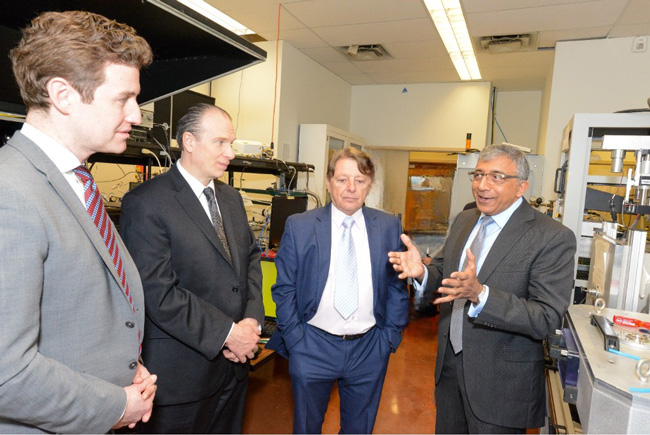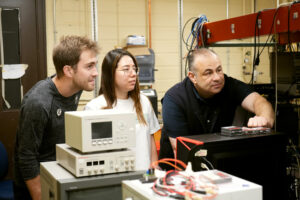
MARCH 7, 2023 • By Matthew Tierney
The perfect window: that’s the goal of ECE professor Nazir Kherani and his collaborators at the start-up 3E Nano Inc.
One aspect of that perfect window is a nano-thin window coating that can more than double the thermal protection for residential and commercial windows. That technology is now on its way to commercialization, thanks in part to $5 million in federal funding from Sustainable Development Technology Canada announced in late February.
Kherani, a co-founder of 3E Nano in 2015, says, “Windows are the weakest energy link in any building. Think of heat escaping in the winter months and heat entering the cool, ventilated space during the summer months.
“A window’s resistance to heat flow is measured by R-value, which is the ability to prevent heat from flowing into or escaping from a building. Currently, 3E Nano windows — in prototype as well as in pre-alpha deployment — rate R8 and higher. This compares remarkably to an average window, whose R-value lies in a range from R1 of a single pane to R3, a dual pane.”
How was 3E Nano able to achieve this breakthrough? In its simplest configuration, the 3E Nano coating comprises a nano-thin metallic film sandwiched between two sapphire-like nano-thin films. This three-layered dielectric–metal–dielectric stack is opaque to certain wavelengths of light, but not others. As a result, the coating can control the flow of light entering and leaving the building over three parts of the solar spectrum: the visible, the near-frequency infrared and the mid-frequency infrared.
Both near-infrared light, which accounts for almost half of the sun’s total energy, and mid-infrared light can be reflected away. This keeps the sun’s heat from penetrating indoors, but it also keeps room heat inside the building (that is, mid-infrared radiation) from escaping through the windows — achieving low emissivity. At the same time, natural visible light is allowed through the window to the interior, reducing the need for artificial interior lighting.
Kherani believes 3E Nano’s coating is poised to become a mainstream product. He credits the industry experience of 3E Nano’s team with a critical pivot in the research.
“Combining earth-abundant aluminum and nitrogen results in a coating material similar to sapphire in its optical and structural properties,” he says. “The stability and multi-functional character of the sapphire-like structure is suited to low-cost, high-volume manufacturing.”
In essence, the coating is a one-dimensional structure which is nano-thin yet strong. It is applied by sputter deposition, a process which hurls argon atoms into an aluminum target in a vacuum system, knocking the aluminum atoms like billiard balls into a light-weight polymer substrate.
After adding nitrogen gas, the resulting chemical reaction forms a colourless sapphire-like film only tens of nanometres thick (approximately one-thousandth of the thickness of a hair strand). This appropriately combined with a nano-thin silver layer results in a robust coating that can be tuned for optical and electrical properties.
Kherani and his team envision other aspects of the perfect window as integrated functionalities ranging from metamaterial structuring to dynamic systems that maintain ideal temperatures and daylighting within buildings.
“In the lab, we've created a metamaterial that retains low emissive and solar control properties but has high transparency in the gigahertz range critical for communication — nature-inspired with near-invisible hexagonal honeycomb patterns,” says Kherani.
“Professor Kherani has his eye on sustainability solutions that remain scalable,” says ECE Chair Professor Deepa Kundur. “His start-up 3E Nano is a shining example of how industry can shape and direct research, and he’s given 3E Nano every chance at a positive impact in the green marketplace.”
She also points out that it’s because of researchers like Kherani that U of T was recently named a top-10 research institution for global innovation.
Kherani is certainly encouraged by the progress of 3E Nano and optimistic about the company’s ability to help transform the building sector, which ranks a close second to transportation in energy-related carbon dioxide emissions.
“Although the shortest distance from point A to point B is a straight line, finding that straight line is not a simple matter. On the other hand, we are in a promising place today, and we can clearly see where we need to be.”


